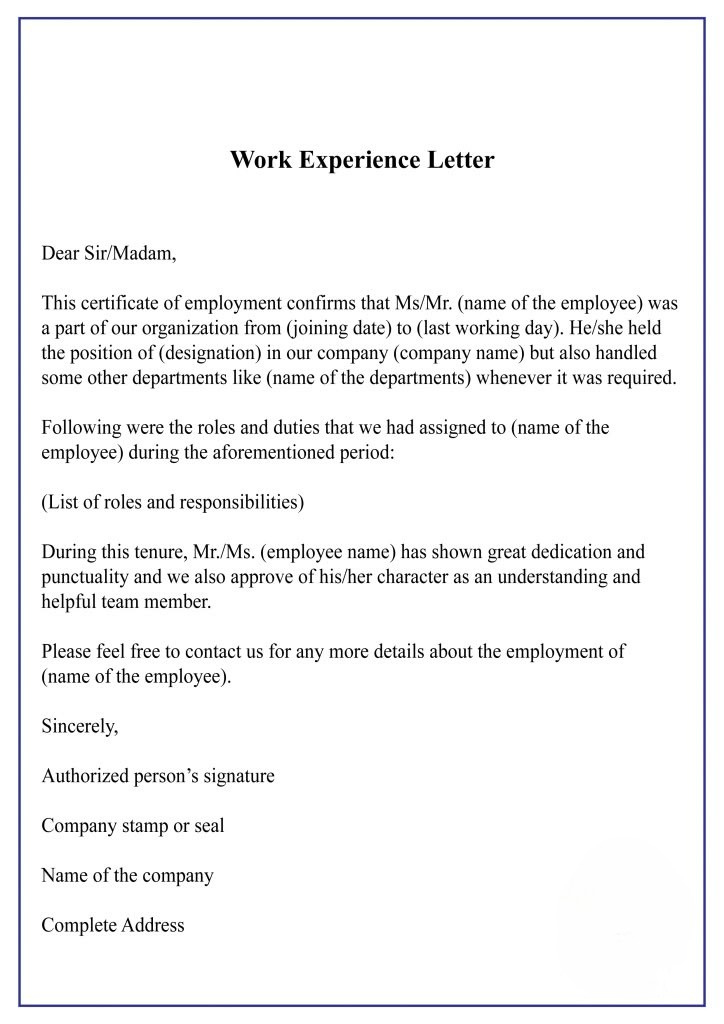What is a Work Experience Certificate?
Key Elements in a Work Experience Certificate
To make an experience certificate effective and valuable, it must include specific details that provide a complete picture of the employee’s role and contribution to the organization. Each element plays a role in validating the employee’s tenure, responsibilities, and character, thereby helping future employers make informed decisions. Below are the essential components you’ll typically find:
1. Employee Information
- Full Name
- Job Title / Designation
- Employee ID (if applicable)
- Dates of Employment (Joining and Exit Date)
2. Roles & Responsibilities
- Details of key responsibilities handled by the employee
- Departments or teams associated with
- Any leadership or managerial role held
3. Performance Review
- Work ethic
- Collaboration and teamwork
- Specific accomplishments
- Consistency and punctuality
4. Achievements
- Recognition or awards received
- Significant projects contributed to or led
- Productivity metrics (if applicable)
5. Character & Conduct
- Behavior in the workplace
- Professionalism and interpersonal skills
- Reputation among peers
6. Salary or Compensation Details (Optional)
- Final drawn salary or benefits received
7. Verification & Contact Information
- HR or Reporting Manager contact details
- Official seal or signature of the company
Why is an Experience Certificate Important?
An experience certificate isn’t just a piece of paper—it is a testament to your professional journey and capabilities. It plays a vital role in career development by offering proof of prior work experience, which is often a fundamental requirement when applying for new roles or switching industries. This certificate not only boosts your credibility but also highlights your reliability, dedication, and domain expertise to prospective employers.
For Employees:
- Proof of Employment: It validates your work history.
- Career Advancement: Required for switching jobs or applying for promotions.
- Educational Opportunities: Certain higher education programs need proof of experience.
For Employers:
- Professional Acknowledgment: It reflects the organization’s professionalism.
- Employee Gratitude: Recognizes and appreciates the contribution of an employee.
How to Request a Work Experience Letter?
While some employers may issue an experience letter automatically, in many cases, you’ll need to formally request one. The process involves reaching out to your HR department or reporting manager and requesting the certificate, preferably in writing. Being proactive and polite in your communication will ensure a smooth process. You can even provide a sample or template to ease the creation of the document.
- Speak to HR or Your Manager: Politely place your request for an Experience Certificate.
- Provide Details: Share your employment details like designation, duration, and department.
- Offer a Draft (Optional): If your organization doesn’t have a standard format, provide one.
- Follow Up: Ensure you receive the certificate on your last working day or soon after.
- Review Before Acceptance: Always check for errors in job title, spelling, or employment dates.
Importance of Accuracy in Experience Letters
It is essential to ensure that the experience certificate accurately reflects your job role, tenure, and achievements. Errors or vague statements can undermine the value of the document and potentially harm your future employment prospects. Always review the certificate carefully and request corrections if necessary. A well-drafted certificate enhances your chances of securing better job opportunities.
Experience Letter - Sample Format
[Employee’s name]
[Employee’s organisation]
[Employee’s address]
[Date of issuance]
[Recipient’s organisation]
[Recipient’s address]
Dear Sir/Madam,
This letter is to certify that [Employee’s name] has worked in our organisation as [Employee’s recent post]. He started working here from [Joining date] until [Leaving Date]. He had served for [total time of work] in our organisation.
During his tenure, he was a highly responsible and dedicated employee. He had enriched himself with many skills and work experiences that he utilised to benefit our organisation. His expertise and dedication were invaluable and contributed significantly to our growth. Some of his mind-blowing skills include [mention his best skills].
He had been paid [Employee’s Salary] monthly, and his work was always of the highest quality. Apart from his love and devotion to work, he was also a very good and kind man who always maintained a good relationship. We are delighted to have such a generous personality among us.
We highly recommend [Employee’s name] for any future job opportunities, and we are confident that he will be an asset to any organisation he joins. We wish him the best of his luck in his career.
Sincerely,
[Sender’s Name]
[Sender’s Designation]
[Sender’s Address]

Difference Between Experience Letter and Relieving Letter
Although both documents are issued when an employee leaves an organization, they serve different purposes. The Experience Certificate confirms the duration and nature of your job role, while the Relieving Letter officially releases you from your duties, confirming that you’ve fulfilled all obligations. Understanding this distinction is important for maintaining a complete professional record.
| Aspect | Experience Certificate | Relieving Letter |
|---|---|---|
| Purpose | The primary purpose of an Experience Certificate is to provide official proof of employment, including the employee's job role, responsibilities, performance, and tenure within the organization. It acts as a testimonial of skills, behavior, and accomplishments. | A Relieving Letter serves as a formal clearance document that confirms the employee has resigned voluntarily, served their notice period, and has been formally relieved of all duties. It assures future employers that the exit was done as per company norms. |
| Issued When | It is generally issued after the employee has successfully completed their tenure or on request after they leave the organization. | This is issued on the employee’s last working day or shortly thereafter, once all formalities like clearance, handovers, and dues are completed. |
| Contents | Includes employee's job title, duration of employment, a summary of key responsibilities, noteworthy achievements, skills demonstrated, and sometimes a positive remark about their character. | Contains confirmation of the employee’s resignation acceptance, last working day, and a statement that they are relieved from their responsibilities. It may also confirm that there are no dues or pending tasks. |
| Tone | The tone of an Experience Certificate is usually appreciative and encouraging, aimed at acknowledging the employee’s contributions and supporting their career growth. | The tone is neutral, factual, and procedural, as it focuses solely on formal resignation and exit compliance without personal or performance references. |
What Makes a Strong Experience Letter?
A well-crafted experience letter is more than just a formal document — it is a powerful testament to an employee’s professional journey, achievements, and contributions. The effectiveness of this letter lies in its structure, authenticity, and the value it provides to future employers. Here are the key components that make an experience letter strong and impactful:
1. Concise Yet Informative
While an experience letter should not be overly lengthy, it must strike the right balance between brevity and depth. A concise letter that delivers the right information effectively is more likely to leave a lasting impression. It should cover the essentials without overwhelming the reader, ensuring clarity and professionalism.
2. Clearly Mentions Roles and Duration
The core of any experience letter is the mention of the employee’s designation, roles and responsibilities, and employment duration. This section confirms the capacity in which the individual served and the time period they were associated with the organization. Clear dates and role details help validate the authenticity of the experience.
3. Highlights Achievements and Skills
A standout experience letter goes beyond generic statements. It should showcase the employee’s key accomplishments, technical and soft skills, and contributions to the organization. Mentioning milestones like successful projects, leadership roles, or recognitions paints a strong picture of the candidate’s value.
4. Includes Contact Information for Verification
Providing a contact number or email address of the issuing authority (usually the HR department or reporting manager) is crucial. This allows future employers to verify the authenticity of the letter, instilling trust in the hiring process and ensuring transparency.
5. Signed by Authorized Personnel
The document should be printed on the company’s official letterhead and be signed by a person in authority, such as a manager, HR representative, or department head. An unauthorized or unsigned letter can raise doubts regarding its legitimacy. Including the signatory’s designation and contact details adds credibility.
Conclusion
A professionally crafted Experience Letter is a cornerstone of your career portfolio. Whether you’re exploring new job opportunities or applying for further studies, this document showcases your abilities, dedication, and value to any future employer. Make sure your experience certificate is thorough, accurate, and well-presented to make a lasting impression.
Employers are encouraged to view this document not merely as a formality, but as a token of appreciation for the employee’s time and talent. Similarly, employees should always ensure to collect it during their offboarding process.
An experience letter is considered as one of the important formal document which is provided to the employee by the employer at the end of their employment after the verification of the tenure, roles and contribution to the company. Experience letters are important because it will serve as proof of work experience, which will enhance candidate credibility and marketability while applying for new jobs and further education.
Experience letter or work experience letter includes the following details: employee full name, job title, date of employment, brief description about the roles and responsibility and company official letterhead and contact information.
Experience letter is issued after the completion of the employment, not on the full notice period. If you have completed the employment even without serving the notice period, you are still eligible to get the experience letter. The company may deduct the unserved notice period from the final settlement.
If you wanted to verify the authenticity of the experience letter, a company can contact the issuing organization or HR department to confirm the details provided in the letter. Further, the verifications include employment records, date of employment, job title and salary information.
If you want to write the experience letter certificate, you must use the company letterhead, which includes the date, employee details, a description about the role and a positive closing statement. The letter must be professional and concise and verify all the information for accuracy.




